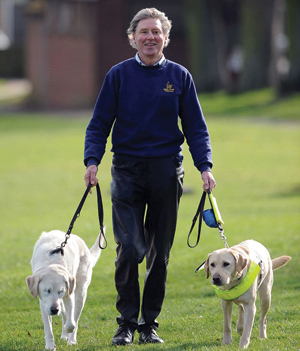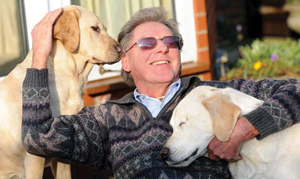BY ABIGAIL GILMORE
 Graham Waspe of Stowmarket, Suffolk, England, and his guide dog Edward spent six great years together, but were recently faced with a challenge like no other, as Edward developed cataracts, The Daily Mail Online reported.
Graham Waspe of Stowmarket, Suffolk, England, and his guide dog Edward spent six great years together, but were recently faced with a challenge like no other, as Edward developed cataracts, The Daily Mail Online reported.
Luckily, Opal, Waspe’s new guide dog, is a real gem – and helping both Edward and Waspe get around together.
Opal was introduced to Waspe last November after Edward’s eye problem worsened and resulted in an operation that removed both of Edward’s eyes.
“Opal’s been great for both of us. I don’t know what we’d do without her,” Waspe said to The Daily Mail Online. And Waspe’s wife, Sandra, told The Daily Mail Online that though Edward has lost his eyes, she doesn’t think he will be slowing down anytime soon, as he still enjoys lots of attention.
While Edward is known in schools and community groups in Suffolk, Opal has become pretty popular as well, as both Graham and Sandra give talks about the Guide Dogs charity, training and the many ways guide dogs are helping their owners, The
Daily Mail Online reported.
There are similar local organizations spreading the same message and providing guide dogs to people with disabilities in Arizona. Terri Hedgpeth, President of Guide Dog Users of Arizona (an affiliate of Guide Dog Users Inc.) said she loves what she does, as it allows her to promote positive attitudes toward guide dogs being active in the community.
Hedgpeth said there are about 14 schools in the U.S. that train dogs to be guides, and the way dogs are chosen to be trained varies for each school. One school, Seeing Eye, where her dog is from, “has an extensive scientific breeding program that looks for genetic traits that are most desirable for a guide such as no hip dysplasia, temperament, lower incidence of cancer, and other longevity factors,” she said. “Seeing Eye also purchases some dogs from reputable breeders for breeding stock.”
 Additionally, some schools have their own breeding programs, she said, while some dogs are taken from animal shelters and trained, and some people train their own dogs.
Additionally, some schools have their own breeding programs, she said, while some dogs are taken from animal shelters and trained, and some people train their own dogs.
Dog training also varies by school, Hedgpeth said. “Seeing Eye trains using verbal praise, repetition and humane correction (verbal scolding), and showing the dog how to find a curb or other obstacle,” she said. “[Seeing Eye] trains their dogs for four to six months.”
On the other hand, “Guide Dogs for the Blind in California and Oregon uses food rewards and their training lasts two to three months,” she said.
And though the way the dogs are found and trained varies, one thing is for certain: these dogs are a part of the community and helping those with disabilities.
If you are interested in getting involved with Guide Dog Users Inc. or a local state affiliate, you can join the organization and volunteer, Hedgpeth said. She said “you may be able to help with fund raising, vet connections, advocacy for legal access to public places and conveyances, help with transportation to and from dog walking events and other dog guide activities, and in so many ways.”
SOURCES






